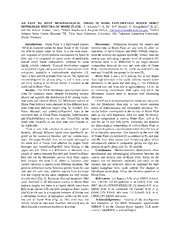
An East to West Mineralogical Trend in Mars Exploration Rover Spirit Moessbauer Spectra of Home Plate PDF
Preview An East to West Mineralogical Trend in Mars Exploration Rover Spirit Moessbauer Spectra of Home Plate
AN EAST TO WEST MINERALOGICAL TREND IN MARS EXPLORATION ROVER SPIRIT MÖSSBAUER SPECTRA OF HOME PLATE. C. Schröder1,2, K. Di3, R.V. Morris2, G. Klingelhöfer4, R. Li3, and the Athena Science Team, 1NASA Postdoctoral Program Fellow, [email protected], 2NASA Johnson Space Center, Houston, TX, 3Ohio State University, Columbus, OH, 4Johannes Gutenberg-Universität, Mainz, Germany. Introduction: Home Plate is a light-toned plateau Discussion: Differences between the eastern and ~90 m in diameter within the Inner Basin of the Colum- western rims of Home Plate are also seen by other in- bia Hills in Gusev crater on Mars. It is the most exten- struments. In Spirit Pancam and MRO HiRISE observa- sive exposure of layerd bedrock encountered by Spirit to tions the western rim appears spectrally ‘redder’ than the date, and it is composed of clastic rocks of moderately eastern rim, indicating a greater level of oxidation [4]. altered alkali basalt composition, enriched in some Whereas there is no difference in the major element highly volatile elements. Textural observations suggest composition between the east and west sides of Home an explosive origin and geochemical observations favor Plate, volatile elements Zn, Ni, and K are enriched in the volcanism, probably a hydrovolcanic explosion [1]. east and Cl and Br are greater in the west [5]. Since it first arrived at Home Plate on sol 744, Spirit has Home Plate is not a level plateau, but in fact slopes circumnavigated the plateau (Fig. 1) and is now, since from high elevation in the south and east towards lower sol 1410, resting at its Winter Haven 3 location at the elevations in the north and west (Fig.1). The difference north end of Home Plate. between east and west side is approximately 4.4 m. As Results: The MER Mössbauer spectrometers deter- an interesting coincidence, both npOx and Ol in the mine Fe oxidation states, identify Fe-bearing mineral Mössbauer spectra seem to increase with decreasing phases and quantify the distribution of Fe among oxida- elevation. tion states and mineral phases [2]. Mössbauer spectra of Ol and npOx increasing together seems anti-intuitive, Home Plate bedrock were obtained in five different loca- but the Mössbauer data may in fact record separate tions from nine different targets (Fig. 1): Barnhill Ace, trends of mineralization and subsequent alteration. Ve- Posey Manager, and JamesCoolPapaBell Stars at the sicular basalts investigated in the vicinity of Home Plate northwest side of Home Plate; Pesapallo, JuneEmerson, such as the rock Esperanza have the same Fe minera- and ElizabethEmery on the east side; TexasChili on the logical composition as eastern Home Plate: rich in Px south side; PecanPie on the west side; and Chanute on and Mt, no Ol and little npOx. Therefore, we interpret the north side. the mineralogical composition of eastern Home Plate as There is very little variation in spectra from a given a record of igneous crystallization rather than the loss of location, although different layers were specifically tar- Ol to alteration processes. The deposits on the west side geted on the northwest location and the eastern loca- of Home Plate crystallized Ol in addition to Px and may tions. The target Barnhill Ace, for example, belonged to initially have been tephra with Fe-bearing glass which the lower unit of Home Plate whereas the targets Posey subsequently altered to palagonite, giving the high pro- Manager and JamesCoolPapaBell Stars belong to the portion of npOx along with Px, Ol, and Mt. upper unit [1]. There is a difference in elevation of a Conclusions: Multi-instrument observations show couple of meters between Barnhill and JamesCoolPapa- geochemical and mineralogical differences between the Bell and yet the Mössbauer spectra from these targets eastern and western rims of Home Plate. Rocks on the look virtually the same [1,3]. There is, however, sub- eastern rim are relatively unaltered, and rocks on the stantial variation in spectra from different locations. The western rim are relatively alterd as indicated by their greatest differences occur between spectra from the east higher nanophase ferric oxide content. The changes in side and the west side, whereas spectra from locations Mössbauer mineralogy follow the elevation gradients of that are roughly on the same longitude are very similar Home Plate. to each other (Fig. 2). Pyroxene (Px) and magnetite (Mt) References: [1] Squyres S.W. et al. (2007) Science, were identified in all Mössbauer spectra of Home Plate 316, 738-742. [2] Klingelhöfer et al. (2003) JGR, 108, bedrock targets, but there is a clearly visible trend from 8067, doi:10.1029/2003JE002138. [3] Morris R.V. et al. little or no olivine (Ol) and little nanophase ferric oxides (2008) JGR, to be submitted. [4] Farrand W.H. et al. (npOx) in the east to a moderate increase of olivine and (2008) LPS XXXIX, this issue. [5] Schmidt M.E. et al. a substantial increase of nanophase oxides on the west- (2008) LPS XXXIX, this issue. ern side of Home Plate (Fig. 2). This trend may not Acknowledgements: Funding of the development strictly follow an east-west direction, but could also be and operation of the MER Mössbauer spectrometer tilted towards a southeast-northwest direction. MIMOS II by the German Space Agency DLR under contract 50QM9902 is acknowledged. BBaarrnnhhiillllAAccee PPoosseeyyMMaannaaggeerr JJaammeessCCoooollPPaappaaBBeellllSSttaarrss CChhaannuuttee PPeeccaannPPiiee PPeessaappaalllloo JJuunneeEEmmeerrssoonn EElliizzaabbeetthhEEmmeerryy TTeexxaassCChhiillii Figure 1. HiRISE Image with digital elevation map of Home Plate. The locations of the Mössbauer targets are indi- cated by arrows. Inset is a smoothed out elevation map Figure 2. Mössbauer spectra of representative targets from five different locations. Rows correspond to relative latitude, columns correspond to approximate relative longitude.
